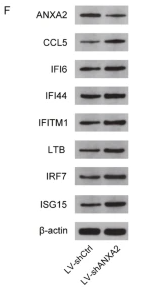SCTR Antibody - #DF5151
| 製品: | SCTR Antibody |
| カタログ: | DF5151 |
| タンパク質の説明: | Rabbit polyclonal antibody to SCTR |
| アプリケーション: | WB IF/ICC |
| Cited expt.: | WB |
| 反応性: | Human |
| 予測: | Mouse, Pig, Bovine, Horse, Sheep, Dog |
| 分子量: | 48 KD; 50kD(Calculated). |
| ユニプロット: | P47872 |
| RRID: | AB_2837341 |
製品説明
*The optimal dilutions should be determined by the end user.
*Tips:
WB: For western blot detection of denatured protein samples. IHC: For immunohistochemical detection of paraffin sections (IHC-p) or frozen sections (IHC-f) of tissue samples. IF/ICC: For immunofluorescence detection of cell samples. ELISA(peptide): For ELISA detection of antigenic peptide.
引用形式: Affinity Biosciences Cat# DF5151, RRID:AB_2837341.
折りたたみ/展開
SCT-R; SCTR; Secretin receptor; SR;
免疫原
A synthesized peptide derived from human SCTR, corresponding to a region within the internal amino acids.
- P47872 SCTR_HUMAN:
- Protein BLAST With
- NCBI/
- ExPASy/
- Uniprot
MRPHLSPPLQQLLLPVLLACAAHSTGALPRLCDVLQVLWEEQDQCLQELSREQTGDLGTEQPVPGCEGMWDNISCWPSSVPGRMVEVECPRFLRMLTSRNGSLFRNCTQDGWSETFPRPNLACGVNVNDSSNEKRHSYLLKLKVMYTVGYSSSLVMLLVALGILCAFRRLHCTRNYIHMHLFVSFILRALSNFIKDAVLFSSDDVTYCDAHRAGCKLVMVLFQYCIMANYSWLLVEGLYLHTLLAISFFSERKYLQGFVAFGWGSPAIFVALWAIARHFLEDVGCWDINANASIWWIIRGPVILSILINFILFINILRILMRKLRTQETRGNEVSHYKRLARSTLLLIPLFGIHYIVFAFSPEDAMEIQLFFELALGSFQGLVVAVLYCFLNGEVQLEVQKKWQQWHLREFPLHPVASFSNSTKASHLEQSQGTCRTSII
種類予測
Score>80(red) has high confidence and is suggested to be used for WB detection. *The prediction model is mainly based on the alignment of immunogen sequences, the results are for reference only, not as the basis of quality assurance.
High(score>80) Medium(80>score>50) Low(score<50) No confidence
研究背景
Receptor for secretin (SCT), which is involved in different processes such as regulation of the pH of the duodenal content, food intake and water homeostasis. The activity of this receptor is mediated by G proteins which activate adenylyl cyclase (By similarity). Upon binding to secretin, regulates the pH of the duodenum by (1) inhibiting the secretion of gastric acid from the parietal cells of the stomach and (2) stimulating the production of bicarbonate (NaHCO(3)) from the ductal cells of the pancreas (By similarity). In addition to regulating the pH of the duodenal content, plays a central role in diet induced thermogenesis: acts as a non-sympathetic brown fat (BAT) activator mediating prandial thermogenesis, which consequentially induces satiation. Mechanistically, secretin released by the gut after a meal binds to secretin receptor (SCTR) in brown adipocytes, activating brown fat thermogenesis by stimulating lipolysis, which is sensed in the brain and promotes satiation. Also able to stimulate lipolysis in white adipocytes. Also plays an important role in cellular osmoregulation by regulating renal water reabsorption. Also plays a role in the central nervous system: required for synaptic plasticity (By similarity).
Phosphorylated on Ser and Thr residues at the cytoplasmic C-terminus by G protein-coupled receptor kinases (GRKs).
Cell membrane>Multi-pass membrane protein.
Belongs to the G-protein coupled receptor 2 family.
研究領域
· Environmental Information Processing > Signaling molecules and interaction > Neuroactive ligand-receptor interaction.
· Organismal Systems > Digestive system > Pancreatic secretion.
参考文献
Application: WB Species: Human Sample: HK2 cells
Restrictive clause
Affinity Biosciences tests all products strictly. Citations are provided as a resource for additional applications that have not been validated by Affinity Biosciences. Please choose the appropriate format for each application and consult Materials and Methods sections for additional details about the use of any product in these publications.
For Research Use Only.
Not for use in diagnostic or therapeutic procedures. Not for resale. Not for distribution without written consent. Affinity Biosciences will not be held responsible for patent infringement or other violations that may occur with the use of our products. Affinity Biosciences, Affinity Biosciences Logo and all other trademarks are the property of Affinity Biosciences LTD.





